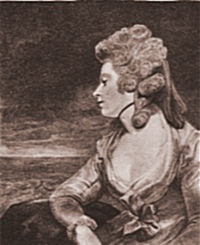
Sacred Texts Classics Sappho
Buy this Book at Amazon.com


Mary Robinson |
Sappho and Phaonby Mary Robinson[1796] |
Mary Robinson, (above) [b. 1758 d. 1800] composed this sonnet sequence about the legendary death of the famous poetess Sappho. Robinson led a dramatic life. Her father, a sea captain, abandoned her mother and five children when she was still a child. Her mother started a girl's school to support herself, and Robinson was teaching in it at age 14. She later trained for the stage and became a professional actress, growing into a legendary beauty. She began a sensational affair when she was 22 with the Prince of Wales, the future George IV, after he saw her play Perdita in a production of The Winter's Tale. After the Prince spurned her, she became a pioneering female author. She wrote novels, poetry, plays and feminist essays. She died in her early forties.
Sappho here differs radically from the version that would emerge in the 19th century. In fact, this had really been the normative view of Sappho since the Renaissance. In this sonnet sequence, which does not appear to contain any actual lines from Sappho, Sappho is the tortured lover of a boatman, Phaon. She follows him to Sicily, and finally leaps off the Leucadian cliffs to her doom. It is not unlikely that this tale of love gone wrong appealed to Robinson on a very personal level. Robinson, during her lifetime, was known as 'the English Sappho,' and has recently been rediscovered as a feminist trailblazer.